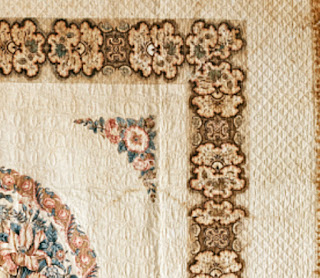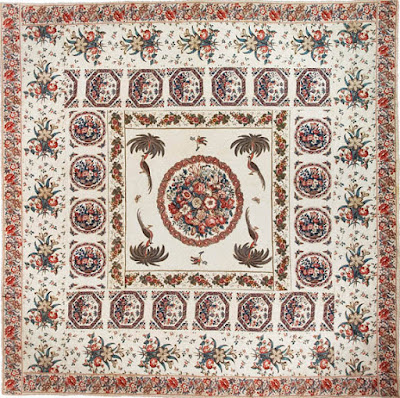Winterthur Museum Collection #1969.3247
Panel #2, a circular wreath of flowers topped with parrot tulips
framed by a scroll.
Flowers on the left include this carnation, a "pink" with its pinked petals.
The scroll pictures feathers and roses.
Four different flowers in the corners
It seems to have been printed in three colorways. We see it most commonly with pinks, tans and blues on white. Several of our examples look to have faded.
The Winterthur's panel shows an added yellow to make greens.
Their panel is unused so the yellow may have tended to fade out with light or washing leaving blues.
The British quilt called the Fife coverlet features a panel in which the
background is more tan than white.
We have 25 American bedcovers with Panel #2---
those with a good history are primarily from the Carolinas.
Quilt attributed to an enslaved woman named Kadella at the Carson House
in Marion in western North Carolina, documented by the North Carolina project.
Yardage of Panel #2 has been cut in half to make the final border....
giving us an idea of the repeat with a narrow strip of white between panels.
One would have to trim that panel closely to make the most of the pattern.
Merikay's collection includes a chintz quilt inscribed 1833 E.H.R.
Panel 2 is framed by four of panel #7 and the final border is the fruit stripe,
a companion to panel #5.
Charleston Museum Collection #HT 584
Quilted in diamonds in an overall pattern, about 105" square
Nothing is listed about the maker or previous owners.
The quilt below follows the formula with more applique in the outside border.

This one is constructed very much like Merikay's with the central square on point, the corners moved out and Panel #7 inside a chintz strip.
It's from an Ebay auction.
It's always fun to see how the designer cut up her square and re-arranged the parts.
In this top she turned the corners and wreath around---
The same ideas seen in the center of the quilt below.
Ann Adeline Orr Parks left several chintz quilts to her family.
In this one panel #2 is trimmed of its scrolly frame and corners,
which fill the space in a large central square on point.
Twelve bouquets from smaller Panel #13, its frames and corners fill the background.
See a post about the Parks quilts here:
A second medallion featuring panel #2 attributed to Ann Orr Parks.
This is quite a successful composition with panel corners integrated
into the scrolly frame and additional chintz applique outside a narrow
floral stripe.
In this medallion, once in the McCarl's collection, the central
panel and its trimmed corners are framed by panel #15. Chintz strips dominate.
The quilting pattern looks to be an all over design of
scallops.
Here's a detail of one from the collection of Lorie Stubbs.
Scallop quilting and triple diagonal-line quilting are apparent in the photo.
Smithsonian NMAH Collection T.12902
Not much is known about this one, similar to Lorie's in use of the panel and in the grid quilting. The woman from Sapphire, Transylvania County, North Carolina,who donated it many decades ago found it in a sale in the 1930s. It's small, about 76" but the curators report a final border appears to have been trimmed off.
See the quilting here:
Quilt attributed to Mary Withers Read (1790 - 1817)
Charleston Museum
This beauty strays from the formula a bit with Panel #3 (The Trophy of Arms) as the central panel and two copies of Panel #2 cut in half diagonally to fill out the center, making for a denser design.
Very much like one in the Smithsonian attributed to the family of
Mary Brewton Motte Alston of the Fairfield-on-the-Waccamaw plantation
near Georgetown County, South Carolina.
The Alston quilt was a little more labor intensive than some of these with
birds, branches, butterflies and flowers appliqued to one of the strips.
The other borders are plain cuts from chintzes.
International Quilt Study Center & Museum #2007.040.0001
Some variation to the formula with four strips of chintz as frames but one of them is cut from yardage of smaller panels #32 & 35.
The cut-out chintz applique in the center features birds and butterflies with the popular pheasant and palm tree print.
Margaret Salena Perkins Laxton's quilt below looks anything but formulaic with its flamboyant palm trees and birds rotating around panel #2. The panel is trimmed of its frame and corners, which are spaced towards the edges. However, the major structure with borders of chintz strips does follow the pattern we see with this panel.
Attributed to Margaret Salena Perkins Laxton (1808-1883)
Perkinsville, Burke County, North Carolina,
Collection of the Museum of Southern Decorative Arts.
MESDA has two quilts attributed to her.
Quilting is a variety of utility patterns in straight lines and grids.
And if it's brightened up we can see the appliqued vignettes
as cut from another popular bird design,
a peacock on a pedestal with a peahen.
The male bird and tree is seen here in Mary Firth's tree of life quilt at the
Philadelphia Museum of Art:
Another quilt featuring the peacock, this one from the
Mississippi project, pictured in their book Mississippi Quilts,
which attributes it to Liza Owens of Grenada County, Mississippi in 1857.
The peacock was probably printed in several variations by different printers.
We couldn't identify the female figure with extended hand.
The Owens quilt is "quilted all over in custom designs, including feathered cables." The family story recalled "the central medallion, or 'quilt square.' as they called it, was sent over from England." This quilt has little of the grace and skillful applique of others in this post but family history indicates it won many ribbons at local fairs.
Charleston Museum Collection # HT742
Trimmed panel for a central focus with 4 pieces of panel #7 in the wide
border of various cut-out chintz motifs, florals, birds and butterflies.
Attributed to Catherine May Crist,
Collection Atlanta History Center
Similar quilt with one copy of Panel #2 and a dozen of Panel #7. Brought from Timberland in Virginia's Shenandoah Valley to Montgomery, Alabama by a great-grandson. See more about #7 here.
Collection of Glorian Sipman
Trimmed central panel with similar small motifs among trimmed versions of panels #9, 12 & 13 in one of a group from the estate of Jennie Clarkson Dreher Hazlehurst (1916-2006) of Columbia, South Carolina, sold at Charlton Hall Auction in that city. Probably connected to Charleston's extended Eason/Banks/Dodderer families. Hugh Rose Banks was a drygoods retailer in Charleston before the Civil War.
Collection of Rowan Museum, Rowan County, North Carolina
Attributed to Jane Locke Young Graham, Rowan County
from the book Arts in Earnest: North Carolina Folklife.
Smaller panel is #13.
Merikay spotted this one years ago on eBay with a central
trimmed panel and a border of chintz.
The seller noted the prominent initials OGR and a date 1869 (a little late we'd guess and perhaps added later). She knew it came from the Reddick family of Reddick, Florida near Ocala. We'd guess the Reddicks were from the Carolinas and sure enough found that Sarah Mills Reddick (1815-1892) of Beech Island, Edgefield on the South Carolina/Georgia line came to Florida in the mid-1850s with husband Ulrick and children. They were married August 11, 1833 and it is more likely the quilt dates to that event with initials of son O.??? added in later too. Or could those initials be UGR for Ulrick Reddick who died in 1869?
Panel extravaganza offered at Skinners' Auctions
five years ago. Around the central panel #2 are panels 6, 7, 12 and 13.
Somebody had some chintz!
Again the corners have been cut and spaced out to fit
inside a strip frame, but every scrap in the cabbage basket
seems to have been included.
The cabbage basket on the floor contained the leftover fabrics
as seen in this 1760 painting by Raspal of a French sewing workshop.
International Quilt Study Center & Museum #2008.040.0032
Dated June 14, 1852, Sumter District, South Carolina
This block format is smaller than many of the medallions, about 83" square. Was it finished?
Signed four times below the vases from a popular print---not a panel.
Corners and frame rearranged.
Art Institute of Chicago, a gift in 1965:
More block style design.
Collection of Spartanburg (SC) Price House
Using the panel as a bouquet in a woven basket.
Very similar thinking below, but this one is a partially appliqued center
with basting for the unfinished parts.
Historic Columbia (SC) Foundation
About 54" square
The baskets are nearly identical---same hand?
The panel seems S-o-o-o Carolinas, but we also have a British example:
ONE British example.
Fife Coverlet, Collection of the Quilters' Guild in Britain
Panel 2 in center.
Makower did a reproduction with a tan ground.
We made a reproduction from the Makower panel with several friends.
What Have We Learned From Panel #2?
Barbara has to admit she's put off posting about Panel #2 because the quilts, "All look the same." But now that we've sorted them out and looked at them closely, it's great that they all look the same. These Carolina medallions tell us a lot. They follow a structural formula, a pattern. In one basic design the panel is on point, the corners are pulled out to enlarge the central area, framed by a series of unpieced strip borders. In the other basic design the central square is on point.
Many of these medallions required little time to stitch; they make the most of beautiful fabrics by focused cutting and graceful compositions. The more we look at these the more we see a professional hand.
The pair of quilts below with their family attributions enabled us to look into the relationships between the families who donated them to the museums. How is it that they look so much alike? Barbara wrote on her Quilt 1812 blog several years ago:
"The similarity of these quilts may be explained by the families being relatives and neighbors in their winter residence on their plantations near Georgetown [South Carolina] and their city residences in Charleston."
But we have changed our minds. The women associated with these quilts were not the makers; they were the owners. The bedcovers were purchased or commissioned, probably in Charleston. Could you buy basted block centers?
http://barbarabrackman.blogspot.com/2018/10/stripes-for-bordering-quilts-poppies.html
More about the Alstons
http://quilt1812warandpiecing.blogspot.com/2012/04/8-theodosia-burr-alston-carolina-coast.html





























































No comments:
Post a Comment